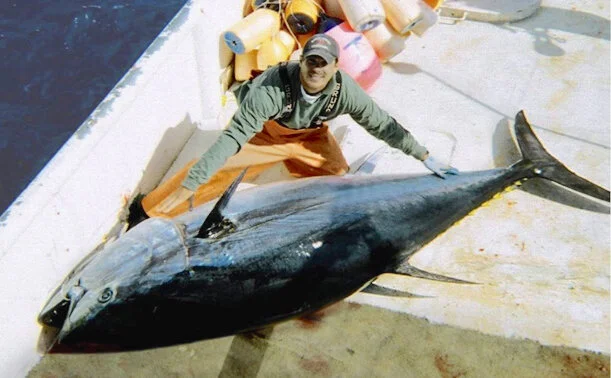Why do we have a World Tuna Day?
By Shelley Dearhart
One of the most incredible predators in our Ocean is in danger of being lost. Pacific Bluefin tuna populations have been in jeopardy for years and new allegations of illegal and overfishing activity by Japanese fleets create a dire need for conservation measures to be taken to protect this species.
Populations have declined by more than 97 percent due to overfishing. Pacific Bluefin tuna breed in western Pacific waters and migrate to eastern Pacific waters to feed crossing international management zones along the way. This creates a challenging situation when trying to protect a species in such high demand that continues to dwindle in number.
Living between 15 to 26 years, Pacific Bluefin tuna mature between the ages of 3-5 years old and are generally around 4-6 feet long at this point. The largest caught was 9.8 feet long and weighed 990 lbs. Adult females (around 6 feet in length) can spawn around 5 million eggs in a year, while the largest female (around 8 feet in length) may spawn 5 times that.
Since the 1990s, catch of immature juveniles has increased, meaning these fish have not yet had an opportunity to reproduce and help replenish the already severely overfished population. Allegations have been made that in Japan last year, 10s of tons of Pacific Bluefin tuna were caught and left unreported or caught without permission. Illegal fishing is a global issue affecting many species of fish, but when it comes to a species that is so incredibly decimated, there is no flexibility for this type of activity. It simply cannot continue. In addition to illegal fishing concerns, Japan, who also catches the majority of Pacific Bluefin tuna, has exceeded the international fishing quota, with two months left in the fishing season.
Large Atlantic bluefin tuna, Thunnus thynnus, on deck. Photo: Fish Watch / Wikimedia Commons
Oceans experts and research organizations such as the Pew Charitable Trusts have continuously brought this issue to the forefront of conversation to stop putting pressure on this critically vulnerable population.
Non-profit organizations and activists’ voices work hard to make positive changes when it comes to protecting the environment but ultimately we, as consumers, must change our everyday practices to stop demand for fish that are so heavily depleted. Not only is Bluefin tuna a species that needs protection, but so many other seafood options are available with lower mercury levels that are delicious and sustainable. If you are set to dine on tuna, try Pacific Yellowfin tuna caught with handlines, poll and troll caught Albacore tuna, or maybe give US Atlantic Wahoo a try caught by any of these three methods. These are all relatively abundant species and using these gear types cause little to no impact to the surrounding habitat.
You have the power to be a part of the change needed to protect Pacific Bluefin tuna. Make the commitment today, on World Tuna Day, not to purchase Pacific Bluefin tuna and empower others to do the same. Be an advocate for new more conservative management efforts to protect this species. We can bring Pacific Bluefin tuna populations back to healthy levels, but it is imperative that we make good seafood purchasing choices in addition to being a voice heard by those making decisions on how to manage them. Follow organizations like the Safina Center, where I work as director of Sustainable Seafood, and Pew Charitable Trusts to learn more about what you can do to help.

